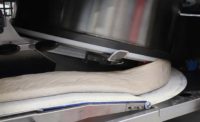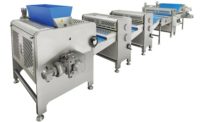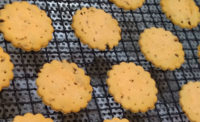Dough comes in many styles, and today’s laminators and sheeters need to accommodate an increasing range of requirements. A combination of automation and artisan qualities, the ability to process naturally soft doughs, single lines that can produce a wide variety of products, condition monitoring and remote maintenance, energy savings, smaller footprints, high weight accuracy, and thoughtful hygienic design with improved access for cleaning—all are among the top requests coming from customers of dough laminators and sheeters for snack and bakery applications.
Market feedback
Sheeting lines use automation to make products previously prepared by hand, yet customers want to retain an artisanal character, says Richard Breeswine, CEO of Koenig Bakery Systems, Ashland, VA. “Our customers ask for keeping the artisan character and for gentle dough processing—for example, rustic bread loaves with long resting times.”
Fritsch GmbH, Markt Einersheim, Germany, finds customers regularly asking for artisanal-looking products, especially bread products, as well as solutions to process natural, soft doughs that comport with a healthy diet and contain no separating agents. Customers also expect very high weight accuracy, says Stefan Praller, senior strategic marketing specialist.
Customers of DrieM Dough Sheeting Technology, Nieuwkuijk, Netherlands, want to make clean-label products with no additives based on shopper interest. “That’s harder than it sounds,” says Maarten Rijken, sales manager. “In the past, we were depending on additives. Now, we need to reach the same or higher quality with just the basic ingredients.”
Koenig has observed a trend toward multi-functionality on one line, Breeswine says. “The product variety is basically endless. Whether bread loaves, hamburger buns or baguettes, the line can be changed from one product to another in only a few minutes.”
Spooner Vicars USA, Plano, TX, has discovered that its customers are looking to infuse all sorts of different ingredients, such as vegetables and potatoes, into crackers, with ingredients in powder form—and to make thinner crackers than in the past. “The equipment needs to work harder, because you need to gauge it better,” says Dan Christie, sales manager. “Then it has to be accurate—if you’re off 10 percent, 5 percent, even 1 percent, when that bakes out of the oven, you get uneven coloring and moisture.”
Rademaker USA, Hudson, OH, has noticed a trend toward greater friendliness of operator interface as customers face more turnover among personnel. “They’re asking, ‘How do you make interfaces easier to understand?’” says Nick Magistrelli, vice president of sales. “We are asked to be a partner today more than ever: ‘Do you have service guys to support us? Do you have technical guys to support our business moving forward?’”
Hygienic design remains an important issue for bakeries, given that flour, dust and waste dough can easily get stuck in baking machines—leading to wear and tear, and potentially even breakdown, Breeswine says. The hygienic aspects of allergens and increased safety continue to become more decisive factors for industrial bakeries.
The Tromp Group, Bunschoten, Netherlands, has seen open-frame design of sheeting and laminating lines becomes more prevalent. This is to facilitate easier start-up after washdown and to remove drag on belts, which could still be wet, notes Adriaan van Houwelingen, senior application specialist.
Erika Record Baking Equipment, Clifton, NJ, says customers want laminators and sheeters that are easy to clean, with easy-access internal components. They’re also looking for energy savings and labor savings, says Daniel Giaquinto, sales associate.
Precise Food Innovations, San Antonio, TX, has seen an increased focus on sanitary design and ease of cleanup, particularly during the raw dough stage, says Greg Stravers, senior vice president. “They want designs with additional standoffs so things don’t get caught, like non-hollow tubes that don’t let bacteria inside.”
David Moline, vice president, sales and marketing, Moline Machinery, Duluth, MN, says his company has worked to make sheeting systems more easily cleanable as sanitation requirements have become more stringent, especially when running products that include meat fillings. “We make them full washdown by standard. Smaller portion sizes are certainly commonplace with respect to the tooling we supply with these systems.”
New and improved
Koenig Bakery Systems has rolled out the Artisan SFM dough sheeting line in “Easy Clean” design, a modular system with round belts and other key parts that can be disassembled without tools. The line provides 33 strokes per minute performance for artisanal bakeries and can be quickly converted to different products.
The SFM line works well with fine-pore doughs as well as large-pore doughs with high water content, which enables a high variety of buns, ranging from whole grain to ciabatta. The machine includes a rounding unit for buns, and different cutting tools enable triangular, quadrangular or rhombic bun shapes.
Baker Perkins, Peterborough, England, has upgraded laminating and sheeting equipment for crackers, hard biscuits and snacks to meet enhanced TruClean hygiene standards, while introducing an entirely new sheeting process that significantly reduces costs in creating cracker-type snacks. Typical cleaning time can be reduced up to 40 percent due to reduced time to gain access and streamlined components.
Baker Perkins offers a combination laminator that produces full ranges of sheeted or laminated cookies or crackers. And the company has added twin-screw extrusion sheeting capability for making cracker-type snacks that’s more compact, cost-effective and flexible than conventional cutting and sheeting lines.
Tromp Group has built laminators up to 17,600 lbs. (8,000 kg) and flatbread lines up to 164 feet (50 meters) per minute, drawing upon momentum around dedicated high-speed lines, as well as more-flexible production lines with shorter changeover times between products, van Houwelingen says. Tromp has redesigned the butter pump to further improve the extrusion process regarding laminated dough, creating a straight-line configuration that minimizes waste while maximizing malleable fat extrusion. And the company has built laminators that eliminate multi-rollers to improve the final lift on product and create more-open grain structure.
Fritsch has developed Smart Services around digitalization of its machines, ensuring smooth communication between the machine, customer and the company’s customer service. These include condition monitoring, which keeps a close watch on important components like motors, frequency converters and sensors, as well as enabling early detection of problems and errors—and subsequent troubleshooting recommendations.
Fritsch’s Data Cockpit service calculates and visualizes efficiency indicators in real-time, and provides the capability of creating custom reports for controlling and optimizing production, depending on a customer’s needs. Remote Maintenance Support assists customers in routine maintenance and troubleshooting, leveraging data for easy communication between the customer and service expert.
Fritsch also has rolled out the Soft Dough Sheeter for especially natural, soft doughs, creating a continuous sheet no matter how soft the dough. The machine is especially suited for artisanal breads and rolls, turning them out as if they were handcrafted.
Erika Record has partnered with Mecnosud, Flumeri, Italy, to distribute both the Mecnosud SB500 Tabletop Sheeter and the Mecnosud SF600 Series Floor Sheeter with an available cutting attachment. The latter contains a see-through glass window over the attachment, notes Jon Cabral, director of advertising and marketing, Erika Record. The former is typically used in a retail environment in which high production is not a priority—and is often for laminated dough, such as croissants.
Erika Record also has partnered with Canol, Santorso, Italy, to offer two pastry makeup and lamination stations—the compact Canolino and the industrial-sized Canol. These units have cutters, laminators and different rollers, Cabral says. “They’re all modular—you can interchange them and move them around. They’re able to be incorporated into an emerging wholesale bakery looking to speed up production, but not able to dedicate space to that sort of equipment.”
DrieM is offering a soft dough-sheeting line that attempts to maximize the liquid ingredients inside doughs, opening up recipe possibilities and overall flexibility. The company also offers cross-moulding to create a “nicely shaped baguette, with a luxurious appearance, at a very high capacity,” says Rijken. The machine creates dimples in the surface of the dough so it doesn’t start sweating and form a skin, improving the appearance.
Spooner Vicars has rolled out a full sheeter line that goes straight from the mixer to the oven that offers a redesigned front end with greater attention to safety and hygienic design, Christie says. With modern design, the A-PEX 400 sheeter uses fewer parts, which makes it easier to clean and maintain, he says, accomplished via the use of 3D CAD. More broadly, the company has been working toward commonality of parts among its sheeters so that customers have an easier time finding spares.
Rademaker has come out with a new mid-range sheeter that handles dough processing of 500 to 3,000 pounds per hour, Magistrelli says. This is to target new customers, but also existing customers with a product line that isn’t mature enough for an industrial-sized sheeter, he says. The target products include yeast-raised donuts, pizza bases and artisan breads, and could extend into laminated categories like pastries and croissants.
Moline Machinery has innovated flour dusters for continuous sheeting systems to make them side-loading, which is more ergonomic for operators and better designed to integrate with bulk four delivery systems. The Side Load Flour Duster removes labor from the sheeting line and provides automatic sensors for when the flour supply is low.
On the laminating side, the Ram Shortening Feeder is designed to apply butter at cold temperatures without removing material in the process. It’s been customized to be integrated with operator workstations and to run on an automated basis “so the operator does not have to pay attention to it for extended periods of time,” Moline says.






